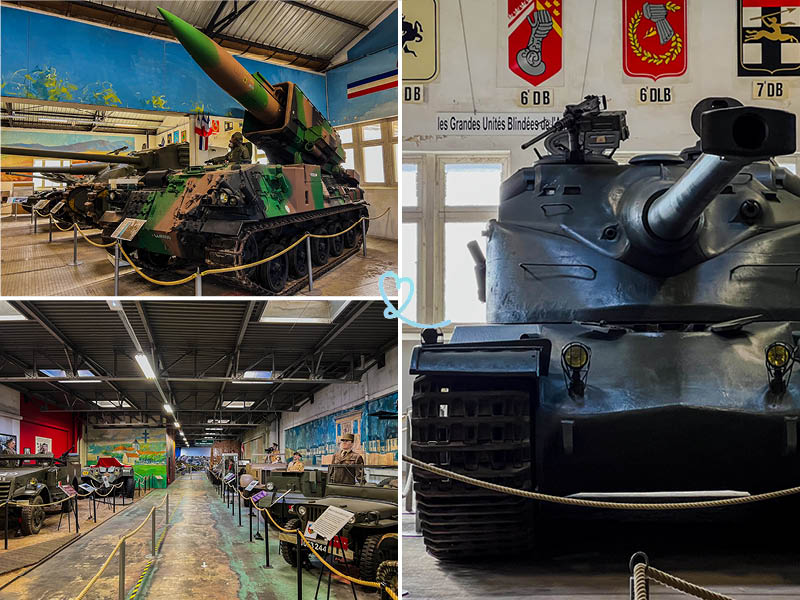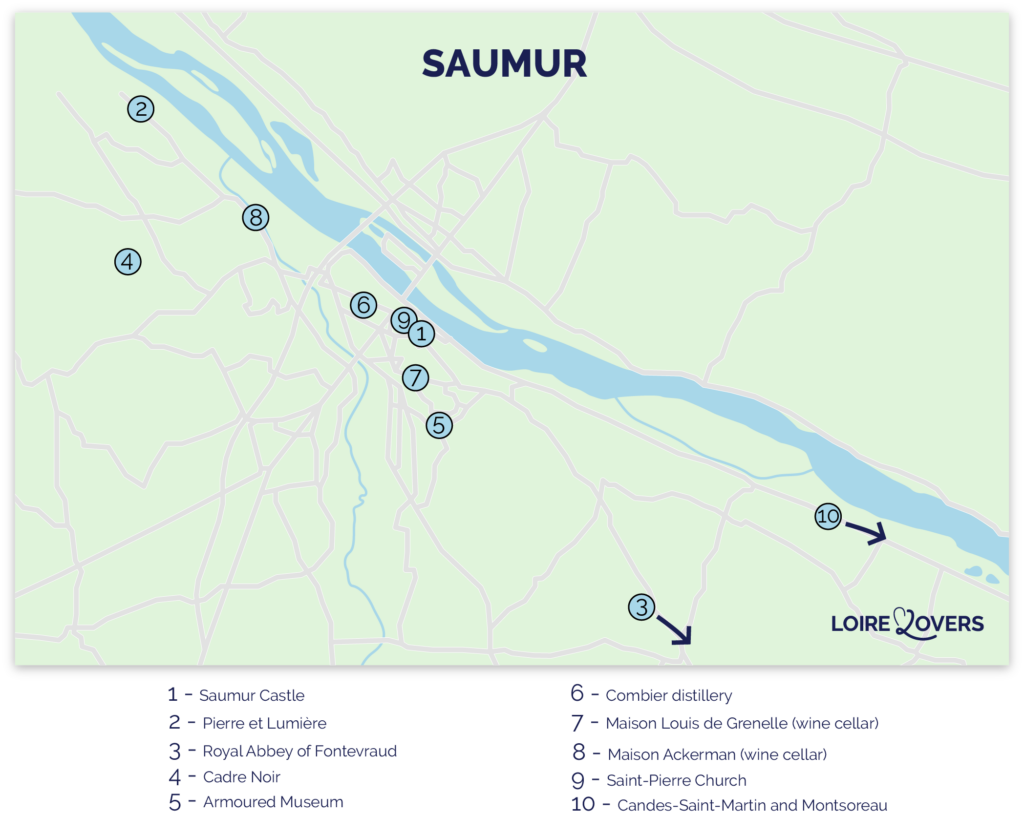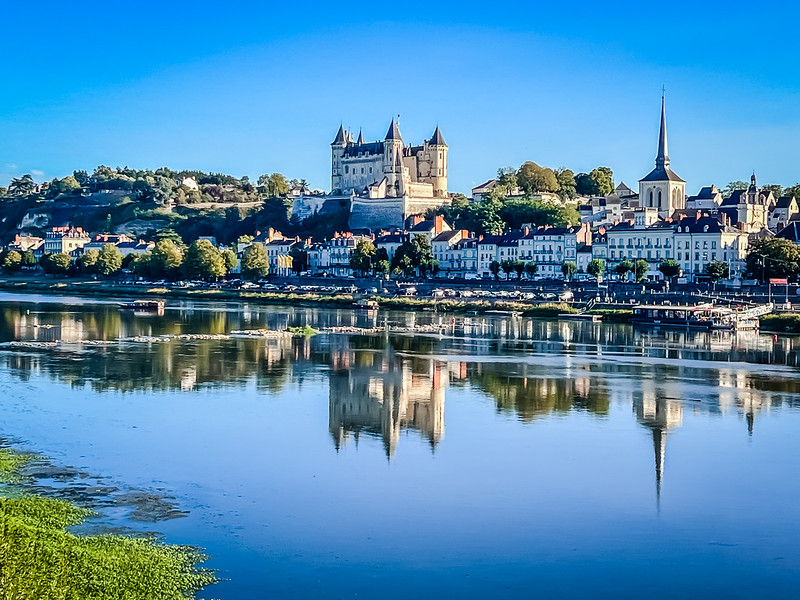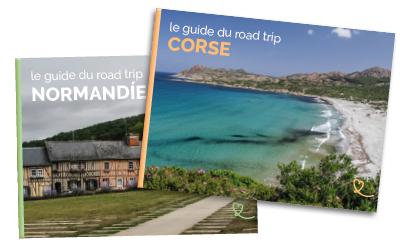We encourage you to visit the Musée des Blindés in Saumur. This prestigious national institution houses an impressive collection of military vehicles, including tanks.
Founded in 1977 under the impetus of Colonel Aubry, it offers visitors a fascinating insight into military history. More than 200 machines are on display throughout the museum. We admired the formidable tanks!
In this article, discover our useful tips in pictures to help you prepare for your visit and spend an enriching moment.

This guide is completely independent, based on our experiences. We visited the region anonymously, making our own choices and paying our bills in full.
Why visit the Armoured Museum in Saumur?
Is the museum worth it? Our opinion:
If you're a military history buff or a war machine enthusiast, we highly recommend a visit to the Armoured Museum. It's a unique opportunity to learn more about combat tactics, military engineering and the impact of armored vehicles on the battlefield. It's an enriching and memorable experience.
Featuring an impressive collection of battle tanks, the museum offers a fascinating insight into the evolution of modern warfare. We admired rare pieces, unique prototypes and equipment used in major conflicts.
In fact, it features in our article on the city's best activities!

Why is the Tank museum of Saumur famous?
In our opinion, the museum is famous for several reasons:
- Its impressive collection of military machines: one of the largest collections of armored vehicles in the world. This complete immersion in history, from the First World War to modern times, left a lasting impression on us!
- Some of these tanks are still operational, and can be seen in historical film productions such as "Un long dimanche de fiançailles" and "La neige et le feu". We found this anecdote quite astonishing!
- Rediscovering the great wars from a different perspective: rather than revisiting the terrible world conflicts that have marked history through conventional exhibitions, we really appreciated the prism of war vehicles. This anchors the visit in the real world.

Our favorite moments
During our visit, 3 moments particularly struck us:
- The Allies of the Second World War Room: in a very concrete way, we became aware of the strong mutual aid that united the Allied countries. Thanks to their human resources and armored vehicles, France was able to achieve victory!
- The Cold War Room: beyond the section of the Berlin Wall we were able to see, you'll discover some disturbing Soviet steel monsters!
- The Contemporary France Room: the half-French, half-American military equipment on display plunged us into more recent conflicts, such as the Indochina War.

WHERE TO STAY IN Saumur
Downtown
Enjoy the city, its restaurants and beautiful architecture.
- Hotel Saint Pierre - a historic stay! - see prices, pictures and availability
- Hotel Château La Marquise - prices, pictures and availability
- Hotel Anne d'Anjou - prices, pictures and availability

In the countryside around
Looking for a bit of peace and quiet, without straying too far from the city of Angers? Here's our suggestion:
- Hotel Demeure de la Vignole - prices, pictures and availability
- Hotel Joly Foudres - unusual in barrels - prices, pictures and availability
- Hotel de l'abbaye de Fontevraud - prices, pictures and availability

History in brief
- Creation of the Centre de Documentation des Engins Blindés under the aegis of Colonel Aubry in 1977. It was then installed in the École d'Application de l'Arme Blindée Cavalerie.
- Given the popularity of the collection (which already included over 200 machines), it was recognized as a public utility in 1983. The Association des Amis du Musée des Blindés administers the site. Find out more here.
- Over the course of 23 years, the museum's collection has grown to more than 800 military objects, including 200 on display. We were impressed by the quality and richness of the exhibits!
- Even today, the work of preserving armored vehicles continues. Some steel monsters have even had their moments of glory, appearing in historic film productions. Watch out the next time you see "Un long dimanche de fiançailles" with Audrey Tautou and Gaspard Ulliel!

Access: Musée des Blindés, Saumur
Where is the museum?
- In Saumur (49400) in the Loire Valley,
- At 1043 Route de Fontevraud,
- South-east of the city center,
- 7 minutes by car, or 30 minutes on foot from the Château de Saumur.
To help you find your way around Saumur and the surrounding area, here's our map of the town's main tourist attractions:

OUR TIPS FOR RENTING A CAR IN Loire
- Compare prices on our preferred platform: DiscoverCars - one of the best rated sites.
- Choose a fairly compact car (many villages have narrowed the road).
- Think aboutfull insurance (parking in big cities is really tight).
- There is a lot of demand, book it early.

How to get there?
The museum is located on the southeastern outskirts of the city center. You can go there:
- By bus: routes 33 and 34 of the Ogalo mobilités network stop close to the museum. You'll then have to finish on foot. Find out more here.
- By bike: you can also rent a bike from Cycl'O de Loire. The journey takes just 10 minutes. Dedicated parking is available on site. Book here.
- On foot: from the Château de Saumur, it's a 30-minute walk to the museum. We recommend passing the Notre-Dame-de-Nantilly church and the Maison Louis de Grenelle on your way.
- By car: it's a 7-minute drive from downtown to the museum.

Parking
The museum offers free parking. It is also accessible to coaches and motor homes.
For cyclists, there's also on-site bike parking.

DISCOVER Saumur
- Best things to do in Saumur
- Where to sleep in Saumur: best hotels
- Where to eat in Saumur: best restaurants
- Visit the Château de Saumur
- Visit Fontevraud Abbey
- The most beautiful castles around Saumur
- Saumur's troglodytes
- itineraries: weekend

Useful tips: duration, schedules, eating...
Best time to visit
To take full advantage of the museum and its unique collection, we recommend arriving in the morning when it opens. Otherwise, lunchtime is generally quieter too. Avoid the late afternoon, as the last entrances are 1 hour before closing time.
More generally, we recommend that you visit us outside the summer months (July and August) and school vacations. This way, you can avoid peak periods. When we went there, the aisles were completely empty. We were free to observe the military machines at our leisure without being disturbed!
We think this place is a must-see during your stay in Saumur, so don't miss out!

Length of visit and main difficulties
In our opinion, you should allow 1h30 to 2h to visit this place.
Set up on one level, you won't encounter any particular difficulties during your visit. The aisles and various showrooms are wide and airy, making it easy to get around.
For those with reduced mobility, wheelchairs are available on loan. Find out more here.

Advice on how to visit
The tour is very easy to follow. We moved from one room to the next without asking too many questions. Your sense of direction is instinctive, but you can retrace your steps if you need to. Room names are clearly indicated.
To follow the chronological order of our visit, you'll go straight to the Allies of the Second World War Room after the France 1940 Room. Then retrace your steps to explore the Cold War Room later.
According to the plan, the order is as follows: first there's a brief introduction to the First World War, before diving into the Second Great War. The Cold War and contemporary world conflicts are explored in a second phase.
To find your way around, take a look at the museum map below:

A LITTLE MORE patience
All the photos, maps, information, good addresses to make your stay in the Loire Valley a success, will soon be gathered in a single ebook!
If you wish to be informed of the publication of our guide on the Loire, register:

Visiting with children
The museum offers a family discovery trail in the form of a booklet-game. It's a fun way to combine history and pleasure!
If your little ones discover a passion for armoured vehicles, why not extend the visit by taking home a souvenir from the museum store?

Schedules and rates
The museum is open from 10am to 5pm from February to April and from November to December (closed on Thursdays), and from 10am to 6pm from April to November (every day).
Before your visit, we strongly advise you to check the opening times and special closing days on the official website here.
Admission is €11 full price. There are discounts for families of 2 adults and 2 children. You can also opt for a combined ticket with the Cavalry Museum.

Guided tours
The museum offers guided tours for groups of 10 or more, by reservation only. An additional €4 will be added to the ticket price.

Catering
A gourmet break is a must! For those planning to have lunch directly on site, a picnic area is available, either indoors or outdoors. You'll need to prepare your packed lunch in advance.
Alternatively, head to the city center for some excellent dining options:
- Restaurant L'Essentiel: with its affordable menu inspired by the market and renewed every season, we had a wonderful time. The location also has plenty of character, making the experience all the more memorable!
- Restaurant L'Escargot 49: from amuse-bouche to dessert, we ate very well. The homemade dishes were delicious and beautifully presented.
- Restaurant Masama: we spent a pleasant moment on the terrace of this friendly establishment. The healthy, colorful cuisine totally won us over!
For more inspiration, check out our full article on the best restaurants in Saumur (coming soon).

Immersion in wartime
Are you ready to immerse yourself in military history? To begin your visit, you'll rediscover the First World War through some fearsome armored vehicles. At the sight of these monsters of steel, we were instantly captivated!

First World War: re-enactment and armoured tanks
Entering this first part of the museum, we observed a life-size reconstruction of a scene from the soldiers' daily lives. The mannequins, dressed in military fatigues, lay in their Battalion Command Post. It was a gentle introduction to the subject that had us right on board!

On another section of wall, you'll discover the different professions within the army and their associated uniforms. Between cuirassiers, gunners, artillerymen, infantrymen and others, they don't wear the same clothes, depending on their function. Which war hero do you see yourself in?

In the room devoted to the armored vehicles used in the First World War, 2 of them particularly impressed us:
- The Renault FT-17 tank: this small tracked machine is lighter and more agile than its counterparts. When we learned that he weighed 7 tons, we couldn't imagine the weight of his peers! He entered service in the summer of 1918, just in time to take part in the final victory.
- The Char Schneider CA-1: its distinctive physiognomy reminded us directly of a boat. This was the first French tank, designed by Colonel Estienne. Nicknamed the "Father of Tanks", he played a decisive role as an artillery officer. Find out more about this great man here.

In this room, you'll find
- Char St-Chamond,
- Renault truck,
- Navy-designed 37mm barrel of the FT-17.
World War II: on the German side
The Germans have learned their lesson from their defeat in the First World War: they must equip themselves en masse with tanks. They soon overcame the restrictions of the Treaty of Versailles, which prohibited them from owning tanks and aircraft. Taking advantage of the German-Soviet Pact, they developed their new military arsenal in Russia. The first Panzer I tanks were tested during the Spanish Civil War. To find out more about this secret agreement between Hitler and Stalin, click here.

Emblematic armored vehicles of the German army during the Second World War, we've taken a particular interest in..:
- The Tiger I: we were stunned to learn that it weighed 53 tonnes, and was travelling at just 45km/h at top speed! With its massive structure and prominent cannon, it would not go unnoticed in wartime. It was operational from the end of 1942 until the German surrender in 1945.
- The Panzerkampfwagen IV (PzKpfw IV or Panzer IV): we positioned ourselves in front of the cannon of this tank during our visit, and it was both an impressive and frightening experience! It was the main German tank during the second half of the war, with production exceeding 9,000 units, resulting in numerous derivatives.

In this space, you can observe, among other things:
- Kettenkrad: a kind of tracked motorcycle,
- Marders: a Russian cannon mounted on a Panzer II chassis,
- Panzer III,
- Tiger II.
Watch the German Room video here.
Opposite: Allied armoured vehicles
Throughout the museum, you'll find the Campagne de France 1940 Room, and the World War II Allies Room. You'll first pass through the room housing the most complete collection of French tanks in service in 1940.

In the Salle Campagne de France, our attention was drawn to the following:
- The Hotchkiss H-39 tank: at 4.22m long, 1.95m wide and 2.15m high, this vehicle caught our eye because of its small cannon. The soldier next to him looks like he could almost overtake him!
- The Char Renault B1 bis: unlike its predecessor, this tank dominated us with its grandeur. This is hardly surprising, given that it was the most powerful French tank in service in 1940!

Many other tanks were also present, including..:
- Renault AMR 33,
- Renault R-39,
- Panhard AMD 178,
- Renault ACG1,
- FCM 36,
- Laffly V15T Unicorn.

We then moved on to the Allied Hall of the Second World War. It does not directly follow the French tank room. First we have to get through the Cold War Room.
As its name suggests, this room is home to Allied armored vehicles. Officially, the war went global in 1941. Nevertheless, the globalization of the conflict had already begun before this date. The first Allied tanks landed in France in 1939: the British Expeditionary Force's Chars Matilda and Chenillettes Vickers.

In this space, we were particularly impressed by..:
- The M4 Sherman tank : in the eyes of the French people, it symbolizes liberation. It was at its head that Division Leclerc entered Paris. However, we were astonished to learn that he wasn't all that popular with the soldiers! It was lightly armoured, poorly armed and rather slow. Find out more about the release here.
- The Ford GPA: a cross between a jeep and a boat, this amphibious vehicle can float in freshwater or very calm seas. Her atypical allure caught our eye! It originated in the United States of America, as did the Char Sherman.

Here's a non-exhaustive list of the other machines you'll come across in the Allied Hall:
- Stuart,
- KV 1,
- AM M8 Greyhound,
- T 34-76,
- Matilda II,
- Valentine Mark III,
- Churchill Mk.V.
After 1945: the start of a new confrontation
Our visit now continues in the room dedicated to the Cold War. It houses the armored vehicles that equipped the USSR and its allies from 1945 to 1991.

The Cold War
Following the Allied victory over Germany in 1945, the world's 2 great superpowers are indirectly at odds. This long period of insecurity is commonly referred to as the Cold War. Political and ideological tensions between the USA and the USSR lasted for several decades, until the dissolution of the Soviet Union in 1991. In this space, the map of the USSR immediately caught our eye, thanks to its intense red color.

A section of the Berlin Wall is on display in the museum. It reminded us of the Mémorial de Caen, which has 2. The contrast between the colorful graffiti, and the reality of this major piece that served to divide a country, left a lasting impression on us.
Built in 1961 to physically separate East and West Germany, this hermetic border symbolized the division of Europe. Its fall in 1989 was a momentous historic event, marking the end of the Cold War and the reunification of the country.

Our photo above shows a Traban 601 used by German soldiers to guard the Berlin Wall.
The Cold War was marked by the nuclear arms race and the proliferation of military alliances. We really grasped the significance of this during our visit. The armoured vehicles impressed us with their menacing appearance!
The Warsaw Pact
Dating from May 8 1955, the Warsaw Pact embodied the opposition of the 2 great blocs: East and West. In this room, we discovered equipment from the Soviet Union and satellite countries. In fact, we've noticed that a significant number of them come from war catches.
A treaty of friendship, cooperation and mutual assistance under a single Soviet command, it includes a number of countries:
- East Germany,
- Albania,
- Hungary,
- Poland,
- Romania,
- Bulgaria,
- Czechoslovakia.

In this area dedicated to the Warsaw Pact, we were struck by..:
- SPR-1 Scrambler: built on a GTS-type armored chassis, it is used against terrestrial transmitters. It was exploited by the German and Czech armies on their border with West Germany.
- The T-62 tank: this medium-sized tank is equipped with infrared night vision. It looks more like the machines we see in modern films and TV series. It was designed in 1963 in the USSR. We learned that he had served in Afghanistan. In fact, the 2 superpowers confront each other indirectly through proxy conflicts: the Gulf War, the Sinai War, and so on.

Other impressive machines include..:
- T 34_85,
- T 72,
- T 54,
- BTR 70,
- BOV 3,
- ZSU 23/4.
Contemporary conflicts
Alas, conflicts on a global scale seem to persist unabated. In this last part of the museum, you'll first be immersed in the recent confrontations involving France. You'll conclude your visit by discovering steel monsters used throughout the world.

France and its military equipment
Shortly after the end of the European conflict, France found itself facing a new war in Indochina. However, the available military equipment, mainly American, is not adapted to the specificities of the terrain. It includes numerous wetlands. To meet its operational needs, France decided to acquire amphibious equipment from the United States, such as the LVT-4 Alligator.

Walking through the Salle France Contemporaine, we noticed the presence of several American tanks. It's indicative of a France weakened by the 2 Great World Wars, and in need of support from its allies.
TheAMX 30 Pluton was an instant attraction on our visit. His huge projectile aimed at the sky was very intimidating! This tank was the French Army's tactical nuclear missile launcher. It was used to halt the advance of enemy forces. Its 27-kiloton warhead is twice the power of the Hiroshima bomb. Pretty scary, isn't it?

In this area, we took the time to observe other French and American armored vehicles, each more formidable than the last:
- Panhard EBR 90 F1,
- AMX Leclerc,
- Jeep Hotchkiss Entac,
- AML 90,
- LVT-4 Alligator,
- M24 Chaffee.

Next, you'll make a detour into the Allée des Grands Hommes and the area dedicated to engines, before moving on to the Salle Époque Contemporaine. The names of the rooms give a clear idea of what you'll find inside.

Wars around the world
Only armored vehicles manufactured after the 2nd World War, or the first versions of equipment still in service today, can be seen in the Contemporary World Room. We have identified 4 main groups: English, American and German productions, as well as productions from various origins.

Great Britain is very present with its 3 heavy tanks. The huge Conqueror stands out from the rest, weighing in at 66 tons and equipped with a fearsome 120mm cannon. In the foreground of our photo, you'll see the Canadian Lynx. Designed in the USA, it was finally adopted by Canadians, who demanded modifications.

As our tour progressed, we were struck by the Cascavel and its two-tone camouflage. The body is Brazilian, the turret French, and the engine German. Before visiting this museum, we were not aware of the multiple origins of certain tanks.

Before concluding your visit, you'll sail from one country to another, discovering a variety of tanks, including..:
- Leopard I,
- Chieftain,
- Scorpio,
- Hornet Malkara,
- EBR ETT.
Subscribe to our Newsletter
- Get away from it all with Region Lovers' beautiful destinations!
- Once a month
- Advertising-free
Frequently asked questions
Is there a gift store in the Tank Museum?
Yes! Take advantage of the museum boutique to bring home a unique item and extend your experience!
Here you'll find
- books,
- models to build,
- miniatures,
- camouflaged textiles for young and old,
- CDs and DVDs,
- toys and games.
Are you sorry you didn't buy a souvenir during your visit? Don't worry, we offer a remote sales service. Place your order here.

Does the museum organize events and demonstrations?
Yes, the museum organizes dynamic vehicle demonstrations every year. It also takes part in the Concours International de Maquettes, and in one-off events with other cultural venues such as the Overlord Museum and the Normandy Victory Museum.
He also takes part in the Carrousel de Saumur, held every year at the École Nationale d'Équitation. Find out more about the event here.

Is the Armoured Museum on the Route de Fontevraud in Saumur?
Yes, the museum is on the Route de Fontevraud, just a 15-minute drive from the famous abbey of the same name.
This is another visit we highly recommend you make during your stay in Saumur. This vast monastic city has had an incredible destiny. Originally an abbey, then a prison, it became a true cultural center in 1975. Listed as a UNESCO World Heritage Site, it stands out for its architectural beauty and unique past. See our article on our experience at the Abbaye Royale de Fontevraud for more information!

PLAN YOUR TRIP IN
Loire Valley
The castles of the Loire Valley

Other places to explore







